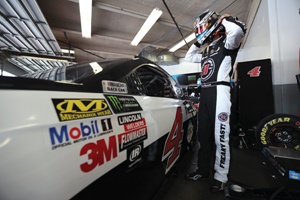NASCAR will roll out a revamped contingency sponsor program next year in its premier series, according to sources, a move that will give teams new inventory on the car to sell and an opportunity to boost revenue.
The move will mark the most significant overhaul of the contingency program since it was first instituted during NASCAR’s founding nearly 70 years ago. It will see current contingency sponsors transition to a new digitally based program to free up space on the cars. It’s a significant change because it takes space on race cars that was owned by the sanctioning body and transfers it to the teams. But it will be inventory that will be sold collectively by teams.
Under the current contingency system, teams place a number of small decals for those series sponsors on their cars’ front-side panels. In exchange for running the decals, or occasionally using the sponsor’s products as well, the teams are eligible for prize money in more than a dozen categories such as the Mobil 1 Driver of the Year Award and the Sherwin-Williams Fastest-Lap Award. Some teams elect not to run the stickers in order to keep a less-cluttered look on their cars, which theoretically provides greater value for primary team sponsors, and are accordingly not eligible for the rewards.
The charter system that was enacted in 2016 granted teams a host of new rights including the ability to exploit the space on cars used by NASCAR’s contingency sponsors. Changes will phase in as current contingency deals expire (the last of which goes through 2021), and teams must still run the decals of NASCAR’s fuel, tire and series title sponsors. This season featured 16 contingency sponsors in NASCAR.
While details are still being worked out, the teams will pool the new space and sell it collectively, similar to a league-type asset, according to Rob Kauffman, chairman of the Race Team Alliance and a co-owner of Chip Ganassi Racing. There are currently 14 teams in the RTA, which teams pay a mid-five-figure annual fee in order to be included, according to sources.
 |
Contingency sponsors get space on front-side panels.
GETTY IMAGES |
It was unclear whether teams would sell several different spots in the contingency area or if they would go with one large partner. It was also unclear how much revenue this could generate for the teams and how it would be shared among the teams. NASCAR declined to comment about the changes.
“The basic idea [of the contingency program] is good, but like the CD versus music downloads, we need to rethink how this works,” Kauffman said. “Just filling up the front quarter panel with a ton of stickers is not really effective in and of itself. So is there a better way? That’s what we’re trying to figure out.”
Under the new system, NASCAR contingency sponsors such as Mechanix Wear and Ingersoll-Rand will have the option to opt into a new program that will include digital and social assets produced by NASCAR to promote the partnerships instead of space on the cars. The exact assets those sponsors will receive were unclear. If a sponsor doesn’t want to opt into the new program, it can remain on the cars until its deal expires, at which point it would need to either switch to the digital program or drop the deal.
Kauffman said the move refreshes the sponsor program and gives teams a way to earn more revenue. Sponsorships make up about 75 percent of their annual revenue.
“It’s a work in progress with the teams and NASCAR on how best to reinvent the system,” Kauffman said. “When it started out, you had Champion’s Spark Plugs and you had a sticker on the car — that’s great but time has moved on a little bit. It’s not that you don’t like Champion and its spark plugs, but that’s maybe not the best way to promote it.”
The marketing subcommittee of the NASCAR team owner council that was created as part of the charter system has been working on the revamp with the sanctioning body, namely NASCAR executives Lou Garate, Jim Cassidy and Michelle Byron.
The move follows a series of changes in recent years as NASCAR and stakeholders seek ways to improve the sport’s business model and racing product, including this past season’s introduction of stage racing and two-day shows for the premier series.
“If we get it right, it can be a good blueprint for the future for sure,” Kauffman said. “That’s why we’re taking a little more time to get it right.”




